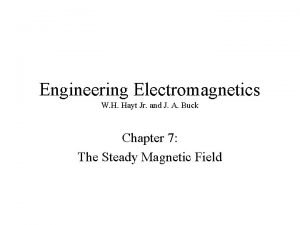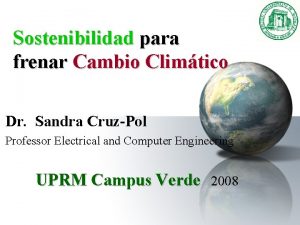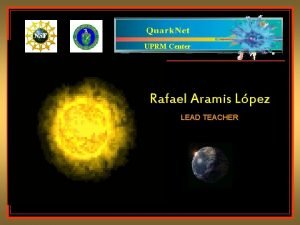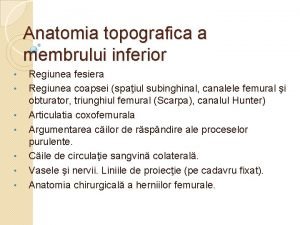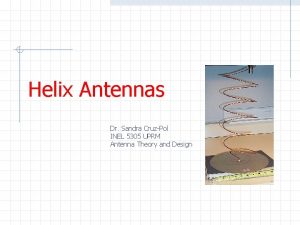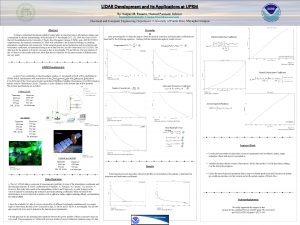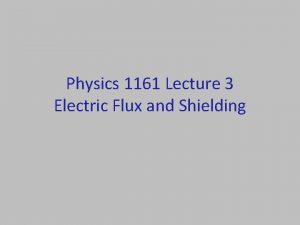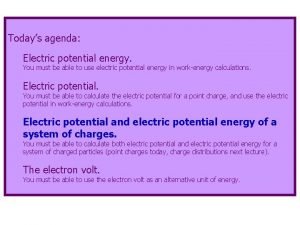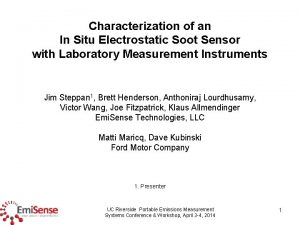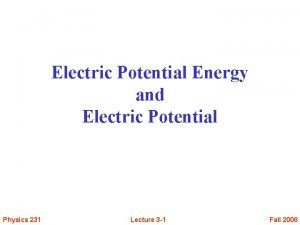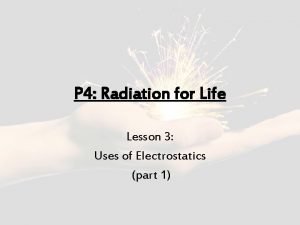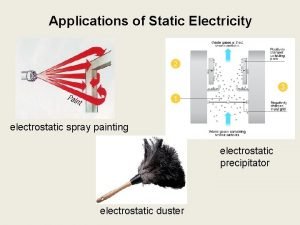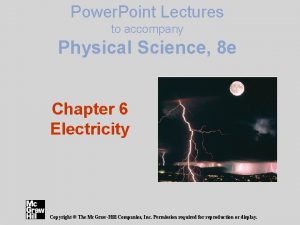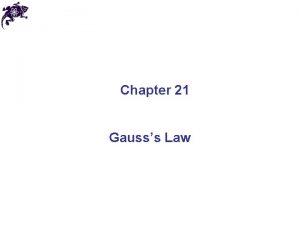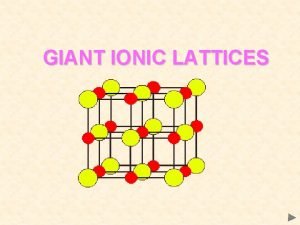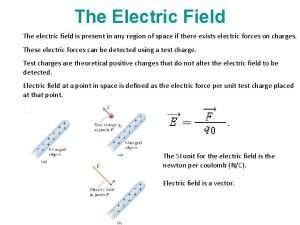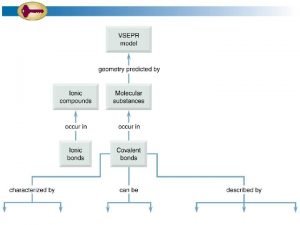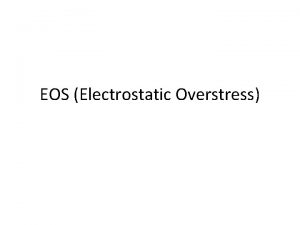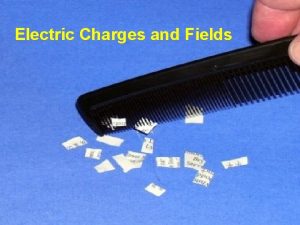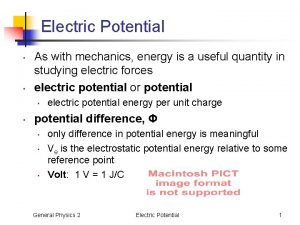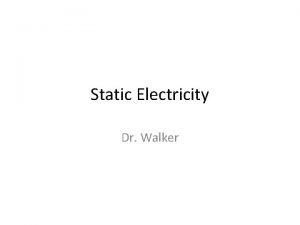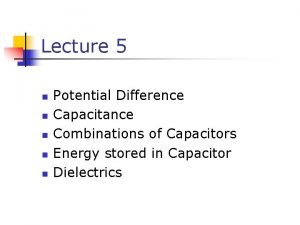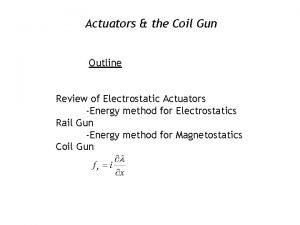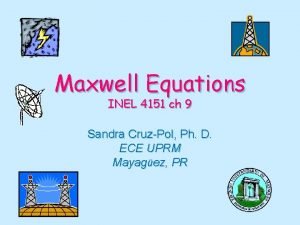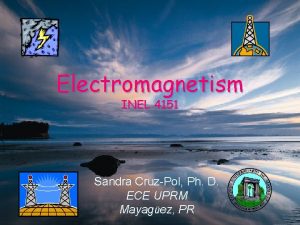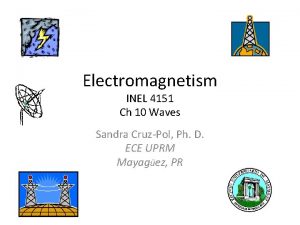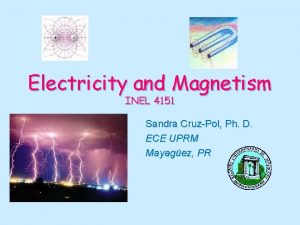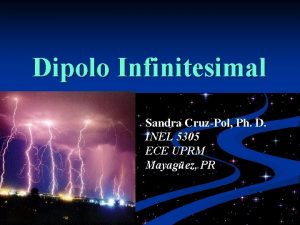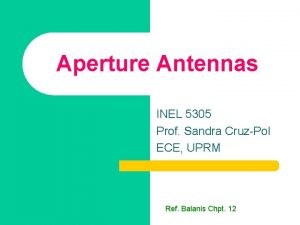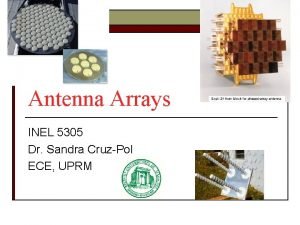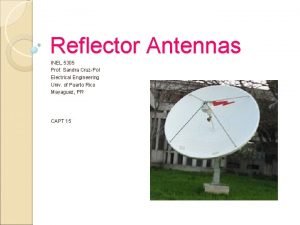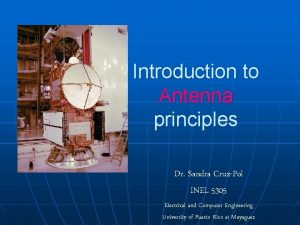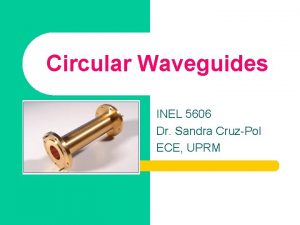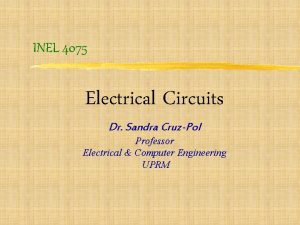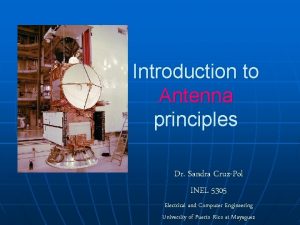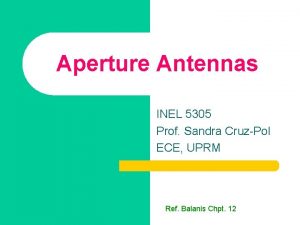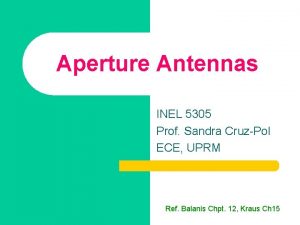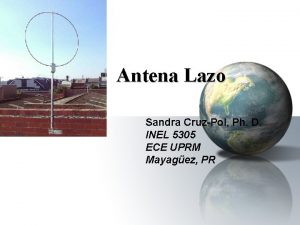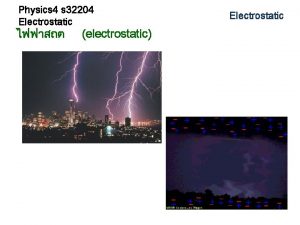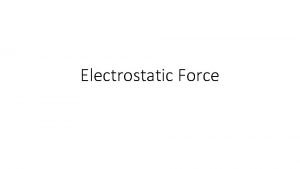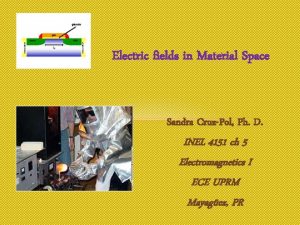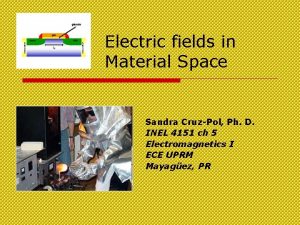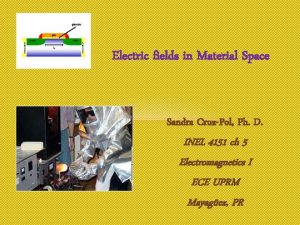Electrostatic fields Sandra CruzPol Ph D INEL 4151








































- Slides: 40

Electrostatic fields Sandra Cruz-Pol, Ph. D. INEL 4151 ECE UPRM Mayagüez, PR

Some applications n n n n Power transmission, X rays, lightning protection Solid-state Electronics: resistors, capacitors, FET Computer peripherals: touch pads, LCD, CRT Medicine: electrocardiograms, electroencephalograms, monitoring eye activity Agriculture: seed sorting, moisture content monitoring, spinning cotton, … Art: spray painting …

We will study Electric charges: n Coulomb's Law n Gauss’s Law

Coulomb’s Law (1785) n Force one charge exerts on another Point charges + where k= 9 x 109 or k = 1/4 peo R + *Superposition applies

Force with direction

Example: Point charges 5 n. C and -2 n. C are located at r 1=(2, 0, 4) and r 2=(-3, 0, 5), respectively. a) Find the force on a 1 n. C point charge, Qx, located at (1, -3, 7) b) Apply superposition:

Electric field intensity n Is the force per unit charge when placed in the E field Example: Point charges 5 n. C and 2 n. C are located at (2, 0, 4) and (3, 0, 5), respectively. b) Find the E field at rx=(1, -3, 7).

If we have many charges Line charge density, C/m r. L Surface charge density C/m 2 r. S Volume charge density rv C/m 3

The total E-field intensity is

Find E from LINE charge z (x, y, z) T a B R (0, 0, z’) n x dl Line charge w/uniform A charge density, r. L 0 d. E

LINE charge z (x, y, z) T a B R (0, 0, z’) n x dl Substituting in: A 0 d. E

More Charge distributions Point charge n Line charge n Surface charge n Volume charge n

Find E from Surface charge z y n Sheet of charge w/uniform density r. S

SURFACE charge Due to SYMMETRY the r component cancels out. n

More Charge distributions Point charge n Line charge n Surface charge n Volume charge n

Find E from Volume charge P(0, 0, z) d. E a (Eq. *) (r’, q’, f’ rv n x q’ f’ ) Differentiating (Eq. *) sphere of charge w/uniform density, rv

Find E from Volume charge P(0, 0, z) d. E (r’, q’, f’ rv q’ ) f’ x n Substituting… De donde salen los limites de R?

P. E. 4. 5 n A square plate at plane z=0 and carries a charge m. C/m 2. Find the total charge on the plate and the electric field intensity at (0, 0, 10).

z of Cont…sheet charge y=2 x=2 Due to symmetry only Ez survives:

Electric Flux Density D is independent of the medium in which the charge is placed.

Gauss’s Law

Gauss’s Law n The total electric flux Y, through any closed surface is equal to the total charge enclosed by that surface.

n Point Charge is at the origin. n Choose a spherical d. S Note where D is perpendicular to this surface. Some examples: Finding D at point P from the charges: D n P r charge

Some examples: Finding D at point P from the charges: Line charge D r P n Infinite Line Charge n Choose a cylindrical d. S Note that integral =0 at top and bottom surfaces of cylinder n

Some examples: Find D at point P from the charges: n Infinite Sheet of charge n Choose a cylindrical box cutting the sheet D sheet of charge Area A D Note that D is parallel to the sides of the box.

P. E. 4. 7 plane y=3 carries charge 10 n. C/m 2. Find D at (0, 4, 3)

P. E. 4. 8 If n C/m 2. Find : volume charge density at (-1, 0, 3) n Flux thru the cube defined by n Total charge enclosed by the cube

Review Point charge or volume Charge distribution Line charge distribution Sheet charge distribution

We will study Electric charges: n Coulomb's Law (general cases) n Gauss’s Law (symmetrical cases) n Electric Potential vectors) (uses scalar, not

Electric Potential, V n The work done to move a charge Q from A to B is n The (-) means the work is done by an external force. The total work= potential energy required in moving Q: n n The energy per unit charge= potential difference between the 2 points: V is independent of the path taken.

The Potential at any point is the potential difference between that point and a chosen reference point at which the potential is zero. (choosing infinity): For many Point charges at rk: (apply superposition) For Line Charges: For Surface charges: For Volume charges:

P. E. 4. 10 A point charge of -4 m. C is located at (2, -1, 3) A point charge of 5 m. C is located at (0, 4, -2) A point charge of 3 m. C is located at the origin Assume V(∞)=0 and Find the potential at (-1, 5, 2) =10. 23 k. V

A line charge of 5 n. C/m is located on line x=10, y=20 Example Assume V(0, 0, 0)=0 and Find the potential at A(3, 0, 5) VA=+4. 8 V r 0=|(0, 0, 0)-(10, 20, 0)|=22. 36 and r. A=|(3, 0, 5)-(10, 20, 0)|= 21. 2

A point charge of 5 n. C is located at the origin V(0, 6, -8)=2 V and Find the potential at A(-3, 2, 6) P. E. 4. 11 Find the potential at B(1, 5, 7), the potential difference VAB

Relation between E and V V is independent of the path taken. B Esto aplica sólo a campos estáticos. Significa que no hay trabajo NETO en mover una carga en un paso cerrado donde haya un campo estático E. A

Static E satisfies: B Condition for Conservative field = independent of path of integration A

x P. E. 4. 12 work done in moving a -2 m. C charge from (0, 5, 0) to (2, -1, 0) by taking the straight-line path. a) (0, 5, 0)→(2, 5, 0) →(2, -1, 0) b) y = 5 -3 x y

Given the potential Example Find D at In spherical coordinates: .

Electric Dipole n z Is formed when 2 point charges of equal but opposite sign are separated by a small distance. P Q+ d Q- r 1 r For far away observation points (r>>d): r 2 y

Energy Density in Electrostatic fields n It can be shown that the total electric work done is:
 Magnetic field intensity
Magnetic field intensity Red fields
Red fields Uprm inel
Uprm inel Colporafia
Colporafia Uprm inel
Uprm inel Uprm inel
Uprm inel Uprm inel
Uprm inel Inel taylor
Inel taylor Uprm inel
Uprm inel Uprm inel
Uprm inel Spina iliaca antero-superioara
Spina iliaca antero-superioara Uprm inel
Uprm inel Uprm inel
Uprm inel Inel kayser-fleischer
Inel kayser-fleischer Electrostatic equilibrium
Electrostatic equilibrium Compound properties
Compound properties Potential energy of system of charges
Potential energy of system of charges Electrostatic painting riverside
Electrostatic painting riverside Smog hog electrostatic precipitators nyc
Smog hog electrostatic precipitators nyc Electrostatic force
Electrostatic force Electric field strength equation
Electric field strength equation Definition of potential gradient
Definition of potential gradient Electric potential
Electric potential Are electrostatic paint sprayers beneficial
Are electrostatic paint sprayers beneficial Use of static electricity in spray painting
Use of static electricity in spray painting Electrostatic charge
Electrostatic charge Electrostatic graphene loudspeaker
Electrostatic graphene loudspeaker Electrostatic instrumentation
Electrostatic instrumentation Surface integral of electric field
Surface integral of electric field Electrostatic series
Electrostatic series Ionic lattices
Ionic lattices What is electrostatic shielding
What is electrostatic shielding Electrostatic potential map of methyllithium
Electrostatic potential map of methyllithium Electrostatic overstress
Electrostatic overstress Electrostatic force
Electrostatic force Amber effect
Amber effect Physics 2
Physics 2 What is triboelectric series
What is triboelectric series Electric potential
Electric potential Electrostatic attraction
Electrostatic attraction Electrostatic actuator
Electrostatic actuator
